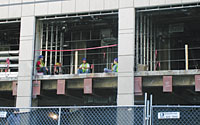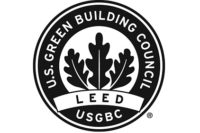
The 62.1 User's Manual from the American Society of Heating, Refrigerating, and Air-Conditioning Engineers (ASHRAE), does justice to IAQ considerations during construction and how it is affected by startup procedures. It's important for HVAC contractors to be aware of this information. If only for the sake of legal protection, keeping up with the latest industry information is a professional responsibility.
According to the document, construction phase requirements apply when a new building is constructed; an addition is attached to an existing building; and when alterations are made to an existing building.
"However," the document states, "not all the requirements are applicable to each of the three circumstances."
FILTERS
"Sometimes, the HVAC system is ready for operation while construction activities are still ongoing," the manual's authors state. "It may be necessary to run the HVAC system to prevent pipe freezing, or if the building is closed in, for the benefit of the construction crew."Some construction activities create quite a heavy load of dust; think of drywalling, for instance. The dust can quickly clog filters, "resulting in a temptation to run a system without filters." The 62.1 Users Manual "requires that systems designed to have particle filters not be operated without them in place." This needs to be coordinated with subcontractors responsible for the system during construction. Make sure they have proper replacement filters available, though not necessarily the same type that will be used when the building is occupied.
The document does not advise that the building's HVAC system is used during construction, for temporary heating/cooling. It can take a heavy toll on the system.
"Equipment manufacturers who become aware that newly installed equipment is used for these purposes may accelerate the commencement and/or termination of the warranty period."
But if it is used, consider using filtration that is adequate for protecting the equipment but not as efficient as those required in occupation for good IAQ. (Always keep the safety of the work crew in mind when deciding on the type of filtration that would be adequate.)
CLEAN AND DRY
It's important to protect building materials from the elements, especially rain and snow, at the construction site and in transit to the site, if the manufacturer recommends protection. A lot of stories have been told of materials getting wet before they are installed, and the mold and general deterioration that results."Building materials made of organic matter (such as wood, paper, or glue), or those that collect organic matter (such as leaves, insects, and grass clippings) that are left exposed outdoors and allowed to get wet can be sites for microbial growth," the manual states.
"More inert materials, such as structural steel and plastic pipe, can be left exposed with no ill effects on indoor air."
In addition, "Porous materials exhibiting visible microbial growth must be decontaminated."
OCCUPIED SPACES
Many construction activities "create contaminants that can impact nearby occupied areas. Such contaminants can be particulate matter from activities such as sanding and gaseous-phase contaminants from activities such as painting."If a building permit has been pulled for the project, the ASHRAE standard requires that steps be taken to stop the contaminants from migrating to occupied areas. Non-building-permit activities would include touch-up painting or cutting drywall to install a junction box.
If there's a permit and the project is likely to create a lot of dust or fumes, occupied areas need to be protected. Some examples of protective measures outlined in the user's manual include:
One method or a combination of the methods may be used.
"Very often, other aspects of construction, such as noise, dirt, movement of materials, and use of elevators by crews, can be intrusive and annoying to building occupants," the manual points out. "These can aggravate the potential air quality effects and therefore might be included in an overall protection plan."
SYSTEM STARTUP
Standard 62.1 has stricter requirements for new system startup, but lesser requirements for systems that undergo more limited alterations, the user's manual points out.
"Balancing procedures are also required for systems that undergo limited alterations that involve reductions in airflow or air distribution modifications that exceed the 25 percent of floor area criterion as described previously."
DRAIN PAN TESTING
Contractors can verify that drain pans for new air handlers are operating properly by field testing, or by proper installation per factory certification."Stagnant water in a drain pan should be avoided," the manual states. "It can be a site for biological contamination, since organic matter is present."
Any drain pan can be field tested, whether the unit was factory manufactured or not. Field-testing, however, is the only acceptable method for testing field-erected (not manufactured) drain pans. The field test must demonstrate that the pan drains under normal operating conditions. It must be operating, and the coil must be dehumidifying.
DAMPER TESTING
Too many IAQ problems have resulted from basic mistakes, such as miswiring dampers. That's why to be in compliance with Standard 62.1, each ventilation system needs to have its outdoor air dampers tested, to ensure that they operate properly and according to the system's design. This needs to be done before occupancy."The automatic outdoor air damper is one of the most essential elements of a mechanical ventilation system," the manual points out. "Many control sequences specify dampers to close when a system is off and open when the system is turned on. More sophisticated designs call for automatic dynamic adjustment of the damper.
"No matter how good the duct system controls and design intentions, if the outdoor air damper does not do what it should, then the occupied spaces will not be properly ventilated."
The 62.1 User's Manual covers many aspects of commercial IAQ, from design and documentation to construction, startup, operations, and maintenance. For more information, contact ASHRAE, 1791 Tullie Circle N.E., Atlanta, Ga. 30329; 800-527-4723 (U.S. and Canada only); 404-636-8400;404-321-5478 (fax).
Sidebar: Contamination
Air ducts need to be constructed according to specific industry standards, the 62.1 User's Manual states. For instance:
Sidebar: Clean Up Your Site
The user's manual for Standard 62.1 makes a case for cleaning up the jobsite, especially around the ventilation system."Dirt or debris left in a ventilation air distribution system can clog coils, filters, turning vanes, diffusers, fan wheels, and other important system components," the authors wrote. "It can also be entrained in the air of the occupied space.
"Therefore, [the standard] requires that ventilation air distribution systems be clean of dirt and debris."
Publication date: 01/16/2006




